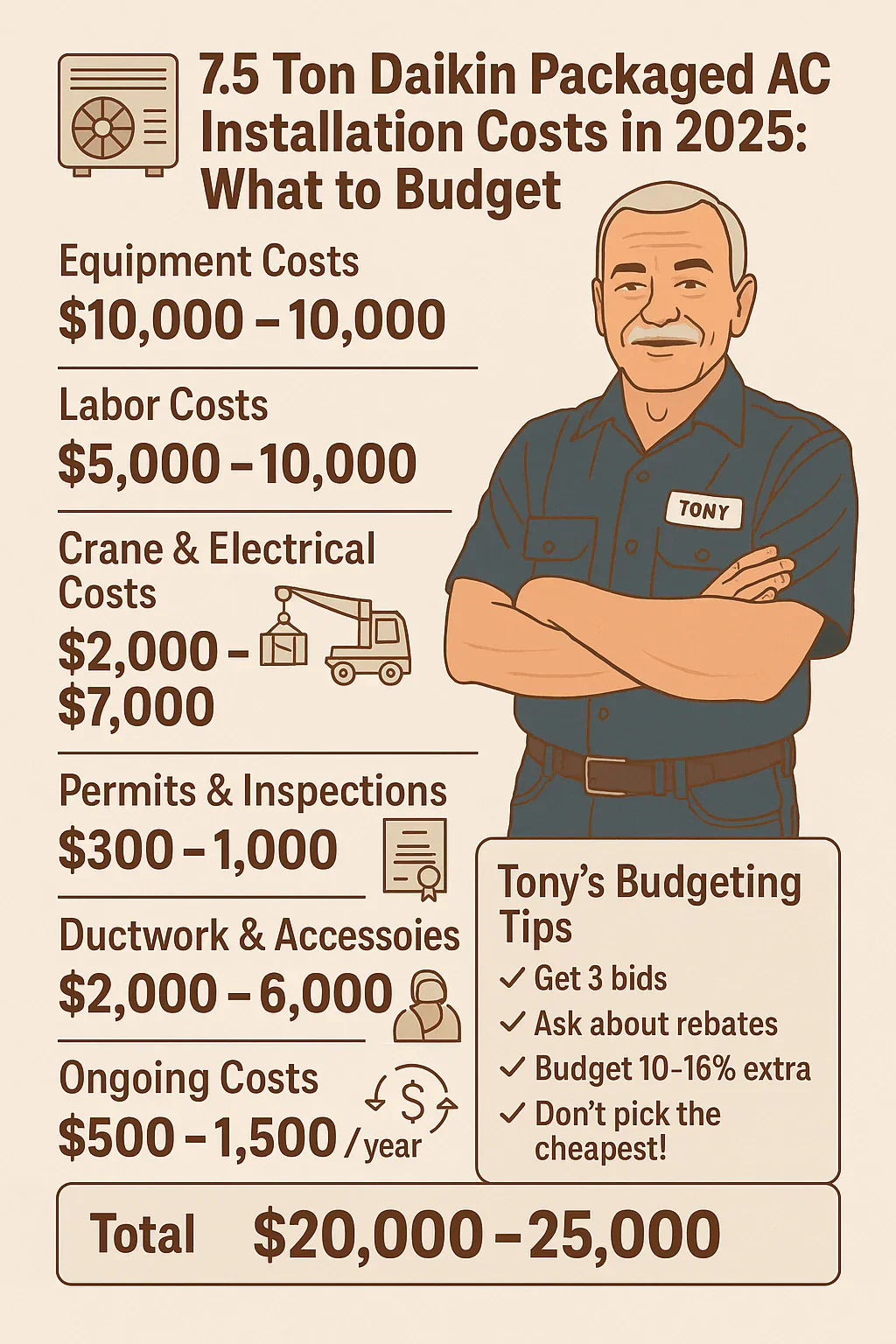If you’ve got a business to run, the last thing you want is surprise costs popping up during an HVAC install. A 7.5 ton packaged air conditioner and gas furnace, like the Daikin Light Commercial 7.5 Ton Packaged AC/Gas Furnace (Model DFG0904DM00001S), is a serious piece of equipment. It can keep 3,500–6,000 square feet comfortable year-round — but installing one isn’t as simple as dropping a box and flipping a switch.
In 2025, you’re looking at $15,000–$25,000 installed for most projects. Let’s break down where that money goes — so you can budget smart, avoid hidden surprises, and keep your business on track.
💲 Equipment Costs in 2025
First, the system itself.
-
Daikin 7.5 Ton Packaged AC/Gas Furnace: $10,000–$15,000
-
Price depends on distributor, features, efficiency upgrades, and any accessories (economizers, curbs, advanced controls).
👉 This covers the unit only, before you even think about installation.
📌 According to HVAC installation cost data, commercial-grade packaged units are significantly more expensive than residential systems due to capacity and complexity.
🛠️ Labor Costs: The Big Variable
Labor is where costs swing the most.
-
Commercial HVAC contractor rates in 2025: $75–$125 per hour per technician.
-
Typical crew size: 2–4 techs + sometimes an electrician and sheet metal worker.
-
Install duration: 2–3 full days for most light commercial packaged systems.
That adds up to:
-
$5,000–$10,000 for labor.
Why so much? You’re not just bolting a system in place. Crews have to:
-
Remove the old unit
-
Set the new packaged system (often with a crane)
-
Connect gas, electric, and ductwork
-
Seal everything properly to meet code
📌 ACCA (Air Conditioning Contractors of America) stresses that quality installation can affect efficiency by up to 30%. Cheap labor often = higher long-term bills.
🏗️ Crane Lifts & Specialized Equipment
If you’re installing this Daikin unit on a rooftop (very common for light commercial setups), you’ll likely need a crane.
-
Crane rental: $500–$2,000 depending on location and access.
-
Permits for road closure or lift: $200–$500 in many cities.
👉 For ground-level installs, you may skip the crane — but still need a forklift or lift equipment.
📌 Trane Commercial HVAC notes rooftop packaged units are popular because they save indoor space, but installation is more complex.
⚡ Electrical & Gas Hookups
These systems aren’t plug-and-play. The Daikin model uses 460V, 3-phase power — standard for commercial but not always readily available.
-
Electrical panel upgrades: $1,500–$5,000 if your building’s panel can’t handle it.
-
Gas line adjustments: $500–$2,000 to size, run, or reconnect properly.
👉 If your building isn’t already set up for 3-phase power, costs rise quickly.
📌 Energy.gov emphasizes electrical compatibility as a hidden cost many buyers overlook.
📑 Permits & Inspections
Commercial installs always need permits.
-
Mechanical permits: $300–$800
-
Electrical permits: $200–$600
-
Gas line permits: $100–$300
-
Inspections: Usually included, but can add $200–$500
👉 Skipping permits is not an option — it risks fines, failed inspections, and insurance issues.
📌 International Code Council updates commercial mechanical codes that local inspectors enforce.
📦 Ductwork & Accessories
Most businesses already have ductwork, but tying in a new 7.5 ton system often requires adjustments.
-
Basic tie-in: $1,000–$3,000
-
Duct modifications/repairs: $2,000–$5,000
-
Economizer (for free cooling with outside air): $1,500–$3,000
-
Curb adapter for rooftop unit: $500–$1,500
-
Vibration isolators: $200–$500
👉 Don’t forget the thermostat. Smart commercial controls can run $500–$1,500.
📌 Carrier Commercial Controls show how advanced thermostats can cut costs further when paired with efficient systems.
🔁 Hidden & Ongoing Costs
Installing the system is just the start.
-
Maintenance contracts: $500–$1,500 per year
-
Filter replacements: $100–$300 annually
-
Coil cleaning & tune-ups: $200–$500 per visit
-
Belt/part replacements: $200–$1,000 as needed
👉 Over 10–15 years, maintenance can add $10,000+ — but it’s worth it. A neglected system runs hotter, breaks sooner, and wastes efficiency.
📌 Energy Star recommends annual maintenance to preserve efficiency ratings like IEER2.
📊 Real-World Budget Examples
Example 1: Ground-Level Retail Store (4,200 sq. ft.)
-
Equipment: $12,000
-
Labor: $6,000
-
Gas/Electrical tie-ins: $2,000
-
Permits: $600
-
Total: $20,600
Example 2: Rooftop Restaurant (3,800 sq. ft., crane needed)
-
Equipment: $13,000
-
Labor: $8,000
-
Crane + permits: $2,000
-
Ductwork mods: $3,000
-
Total: $26,000
Example 3: Medical Office (5,000 sq. ft., ground install with curb)
-
Equipment: $11,500
-
Labor: $5,500
-
Curb adapter + controls: $2,000
-
Maintenance contract year 1: $1,200
-
Total: $20,200
✅ Tony’s Budgeting Tips
-
Get 3 quotes from licensed contractors before signing.
-
Ask about rebates & tax credits. A 14.8 IEER2 system often qualifies for utility or ENERGY STAR incentives.
-
Budget 10–15% extra. Unexpected duct or electrical issues always pop up.
-
Don’t pick the cheapest installer. Bad installs kill efficiency and void warranties.
📌 Total Installed Cost Range (2025)
-
Ground install, minimal extras: $15,000–$18,000
-
Rooftop with crane & mods: $20,000–$25,000
👉 The sweet spot for most businesses will land around $18,000–$22,000.
📌 Final Word from Tony
Installing a 7.5 ton Daikin packaged unit isn’t just an equipment purchase — it’s a project. Between labor, permits, cranes, and ductwork, the install costs often match or exceed the unit price.
But if you budget smart — figure $18k–$22k all-in — you’ll get a system that delivers reliable comfort, solid efficiency, and peace of mind for the next 10–15 years.
Remember: don’t just buy the box — budget for the whole job. That’s how you avoid headaches and keep your business running smooth.
In the next topic we will know more about: Single-Stage vs. Two-Stage Packaged Systems: Which Is Best for Commercial Comfort?







